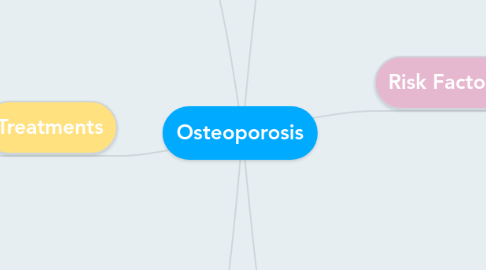
1. Diagnostics
1.1. Dual x-ray absorptiometry (DXA)
1.1.1. low radiation x-ray used to detect small percentages of bone loss
1.1.2. used to measure spine and hip density
1.1.3. can measure the entire skeleton for bone density
1.2. Test results
1.2.1. Normal
1.2.1.1. t-score of -1 or above
1.2.2. osteopenia
1.2.2.1. t-score lower than -1 and greater than -2.5
1.2.3. osteoporosis
1.2.3.1. t-score of -2.5 or lower
1.2.4. severe osteoporosis
1.2.4.1. t-score of -2.5 or lower, and presence of at least one fragility fracture
1.3. other tests done in clinical trials
1.3.1. radiological assessmer
1.3.2. Bone Turnover arkers (BTM)
2. Treatments
2.1. Medications prescribed
2.1.1. Alendronate (fosamax)
2.1.2. Risedronate (Actonel, Atelvia)
2.1.3. Ibandronate (Boniva)
2.1.4. Zoledronic Acid (Reclast)
2.2. Hormone-related therapy
2.2.1. Estrogen helps maintain bone density
2.2.2. Raloxifene (Evista)
2.2.2.1. acts as estrogen, helping bone density in women after menopause
2.2.3. in men, testosterone replacement therapy
2.2.3.1. helps improve symptoms of low testosterone
2.3. Alternative medicine
2.3.1. soy protien
2.3.1.1. appears to have similar effects as estrogen
2.3.2. ipriflavone
2.3.2.1. combined with calcium appears to prevent bone loss and reduce pain
3. Clinical Manifestations
3.1. fractures
3.1.1. occur because the trabeculae of spongy bone become thin and sparse
3.1.2. compact bone will become porous
3.2. bones will lose volume
3.2.1. bones can become brittle and weak, collapsing or losing shape
3.2.2. vertebral collapse causes kyphosis
3.3. Fatal complications
3.3.1. fat or pulmonary embolism
3.3.2. pneumonia
3.3.3. hemorrhage
3.3.4. shock
3.4. Common
3.4.1. pain in areas of fracture
3.4.2. bone deformity due to a fracture
4. Pathogenesis
4.1. develops whenever bone resorption and none formation are disrupted
4.1.1. inbalance in the coupling process results
4.1.2. osteoclasts help absorb bone tissue during healing
4.2. Glucocorticoid-induced osteoporosis
4.2.1. increase RANKL expression and inhibit OPG production by osteoblasts
4.2.1.1. decreasing bone density
4.3. age related bone loss
4.3.1. decreased serum growth hormone
4.3.2. decreased insulin-like growth factor 1
4.3.2.1. all affecting ostoblast and osteoclast function
4.3.3. increased binding of RANKL
4.3.4. decreased OPG production
5. Risk Factors
5.1. Unchangeable risks
5.1.1. Gender
5.1.1.1. Women a have a higher risk
5.1.2. Age
5.1.2.1. higher risk for older patients
5.1.3. Race
5.1.3.1. white and people of asian decent are at a higher risk
5.1.4. Family History
5.1.4.1. having a parent or sibling with this disease increases your chances
5.1.5. Body Frame Size
5.1.5.1. smaller frame sized people have a higher risk
5.2. Hormone Levels
5.2.1. Sex Hormones
5.2.1.1. a lower sex hormone levels tend to weaken the bone
5.2.2. Thyroid Problems
5.2.2.1. too much thyroid hormone can cause bone loss
5.2.3. Other Glands
5.2.3.1. also has been associated with overactive parathyroid and adrenal glands
5.3. Dietary Factors
5.3.1. Low Calcium Intake
5.3.1.1. a lifelong lack of calcium increase the risk
5.3.2. Eating Disorders
5.3.2.1. restricting food intake and being underweight weakens bone in both men and women
5.3.3. Gastrointestinal Surgery
5.3.3.1. surgery reducing the size of your stomach leads to loss of nutrients, including calcium
5.4. Lifestyle Choices
5.4.1. Sedentary Lifestyle
5.4.1.1. people who sit all day and are less active could develop osteoporosis
5.4.2. Excessive Alcohol Consumption
5.4.2.1. more than two alcoholic beverages per day increases your risk
5.4.3. Tobacco Use
5.4.3.1. contributes to weak bones, even if experts do not know the exact role
5.5. Medical Conditions
5.5.1. Celiac Disease
5.5.2. Inflammatory Bowel Disease
5.5.3. Kidney / Liver Disease
5.5.4. Cancer
5.5.5. Lupus
5.5.6. Multiple Myeloma
5.5.7. Rheumatoid Arthritis
6. Incidence / Prevalence
6.1. Worldwide
6.1.1. more than 8.9 million fractures annually
6.1.2. an osteoporotic fracture every 3 seconds
6.1.3. effects 200 million women
6.1.3.1. 1/10 of the women are 60 years old
6.1.3.2. 1/5 are 70 years old
6.1.3.3. 2/5 are 80 years old
6.1.3.4. 2/3 are 90 years old
6.1.4. more than 180,000 nursing home admissions annually
6.1.5. more than 432,000 hospitla admissions annually
6.1.6. nearly 2.5 million medical office visits annually
